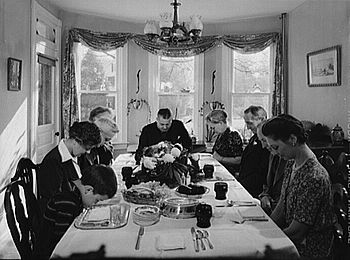| English: "The First Thanksgiving at Plymouth" (1914) By Jennie A. Brownscombe (Photo credit: Wikipedia) |
First Fruits was actually third in the yearly celebrations coming on the day after the Sabbath following Unleavened Bread.
Passover was held during the first month of the Jewish year. It commemorated the exit of the Jewish people from Egypt, so giving thanks was inherent in the ceremony. They were thankful for release from bondage. The Festival of Unleavened Bread began the next day and lasted for seven days. It continued the celebration by remembering the wandering in the wilderness and the manna that God provided for their sustenance.
Leaven represented the contamination caused by exposure to the world, other cultures, and mankind's original sin. Most of the bread and grain offerings were specified to be without yeast, but the feast of Pentecost or the Feast of Weeks was celebrated the day following the seventh Sabbath after First Fruits and celebrate the fertility of the land, and the sacrifice includes two loaves of bread made with yeast. I loved this because it indicates God's acceptance of us even with our faults and failures. Passover had been symbolic of the sacrifice of Jesus, and First Fruits indicates that God loves us even in our human condition. Originally Pentecost marked the giving of the Law. In the Christian calendar it marks the coming of the Holy Spirit.
The Biblical feasts in the fall of the Jewish calendar include Passover, Unleavened Bread, First Fruits, and the Feast of Weeks. Christians celebrate these in the Spring or Summer. The Fall celebrations are Trumpets, Day of Atonement and Tabernacles. Again, the times are reversed, and in our present calendar, they come in the Spring.
| English: Saying grace before carving the turkey at Thanksgiving dinner in the home of Earle Landis in Neffsville, Pennsylvania (Photo credit: Wikipedia) |


No comments:
Post a Comment